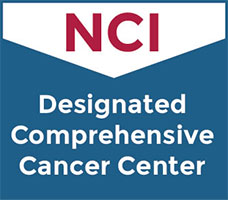Patient Search
 |
 |
|
KaCrole Higgins was diagnosed with breast cancer in 2020. “In May 2020, I found a lump in my breast. I cried. By June, it was diagnosed as breast cancer, triple positive, stage 1A. While getting this cancer diagnosis was devastating, it also became an opportunity. Suddenly, the cancer gave me clarity. It gave me clarity about what was important, what was good in my life, what was toxic in my life, and what I needed to do.” Click below to read more of KaCrole’s story |
If Landon Ryan had been diagnosed with bilateral retinoblastoma 10, 20 or 30 years ago, she might not be here today with nearly perfect vision.Thanks to recent improvements in the treatment for this rare form of cancer that almost exclusively affects children under the age of 5, the diagnosis had the power to change Landon’s life when she was 11 months old, but not to take it — or her eyesight. Click below to learn more about Landon and her story. https://momentum.vicc.org/2022/04/brighter-outlook/ |
A Study to Assess Adverse Events of Intravenously (IV) Infused ABBV-383 in Adult Participants With Relapsed or Refractory Multiple Myeloma
Multiple Myeloma (MM) is a cancer of the blood's plasma cells ( blood cell). The cancer is typically found in the bones and bone marrow (the spongy tissue inside of the bones) and can cause bone pain, fractures, infections, weaker bones, and kidney failure. Treatments are available, but MM can come back (relapsed) or may not get better (refractory) with treatment. This is a study to determine adverse events and change in disease symptoms of ABBV-383 in adult participants with relapsed/refractory (R/R) MM.
ABBV-383 is an investigational drug being developed for the treatment of R/R Multiple Myeloma (MM). This study is broken into 3 Arms; Arm A (Parts 1 and 2), Arm B and Arm C. Arm A includes 2 parts: step-up dose optimization (Part 1) and dose expansion (Part 2). In Part 1, different level of step-up doses are tested followed by the target dose of ABBV-383. In Part 2, the step-up dose identified in Part 1 (Dose A) will be used followed by the target dose A of ABBV-383. In Arm B a flat dose of ABBV-383 will be tested. "In Arm C, the step-up dose identified in Arm A will be used followed by the target dose of ABBV-383 to investigate outpatient administration of ABBV-383. Around 180 adult participants with relapsed/refractory multiple myeloma will be enrolled at approximately 40 sites across the world.
Participants will receive ABBV-383 as an infusion into the vein in 28 day cycles for approximately 3 years.
There may be higher treatment burden for participants in this trial compared to their standard of care. Participants will attend regular visits during the study at a hospital or clinic. The effect of the treatment will be checked by medical assessments, blood tests, checking for side effects and questionnaires.
ABBV-383 is an investigational drug being developed for the treatment of R/R Multiple Myeloma (MM). This study is broken into 3 Arms; Arm A (Parts 1 and 2), Arm B and Arm C. Arm A includes 2 parts: step-up dose optimization (Part 1) and dose expansion (Part 2). In Part 1, different level of step-up doses are tested followed by the target dose of ABBV-383. In Part 2, the step-up dose identified in Part 1 (Dose A) will be used followed by the target dose A of ABBV-383. In Arm B a flat dose of ABBV-383 will be tested. "In Arm C, the step-up dose identified in Arm A will be used followed by the target dose of ABBV-383 to investigate outpatient administration of ABBV-383. Around 180 adult participants with relapsed/refractory multiple myeloma will be enrolled at approximately 40 sites across the world.
Participants will receive ABBV-383 as an infusion into the vein in 28 day cycles for approximately 3 years.
There may be higher treatment burden for participants in this trial compared to their standard of care. Participants will attend regular visits during the study at a hospital or clinic. The effect of the treatment will be checked by medical assessments, blood tests, checking for side effects and questionnaires.
Not Available
I
Not Available
NCT05650632
VICC-DTPCL23010P
Dose Optimization and Expansion Study of DFV890 in Adult Patients With Myeloid Diseases
Hematologic
Hematologic
Study CDFV890G12101 is an open-label, phase 1b, multicenter study with a randomized two-dose optimization part, and a dose expansion part consisting of three groups evaluating DFV890 in patients with myeloid diseases. The purpose of this study is to assess the safety, tolerability, pharmacokinetics, pharmacodynamics, efficacy and recommended dose for single agent DFV890 in patients with lower risk (LR: very low, low or intermediate risk) myelodysplastic syndromes (LR MDS), lower risk chronic myelomonocytic leukemia (LR CMML) and High-Risk Clonal Cytopenia of Undetermined Significance (HR CCUS).
Hematologic
I
Kishtagari, Ashwin
NCT05552469
VICC-DTHEM23007P
A Phase 1 Study of AB521 Monotherapy and Combination Therapies in Renal Cell Carcinoma and Other Solid Tumors
Multiple Cancer Types
The purpose of this study is to evaluate the safety and tolerability of:
* casdatifan when taken alone in participants with advanced solid tumor malignancies and clear cell renal cell carcinoma (ccRCC) during the dose escalation stage; and
* casdatifan monotherapy and casdatifan in combination with cabozantinib or zimberelimab in participants with ccRCC in the dose expansion stage
* casdatifan when taken alone in participants with advanced solid tumor malignancies and clear cell renal cell carcinoma (ccRCC) during the dose escalation stage; and
* casdatifan monotherapy and casdatifan in combination with cabozantinib or zimberelimab in participants with ccRCC in the dose expansion stage
Kidney (Renal Cell),
Phase I
I
Rini, Brian
NCT05536141
VICC-DTURO23168P
Nilotinib Plus Dabrafenib/Trametinib or Encorafenib/Binimetinib in Metastatic Melanoma
Multiple Cancer Types
This is a phase 1 dose-escalation study of nilotinib in combination with fixed-dose dabrafenib and trametinib regimen for patients with metastatic or unresectable melanoma carrying a BRAF V600 mutation and have relapsed on a BRAF/MEK inhibitor therapy. The goal is to assess the toxicity and tolerability and determine the maximum tolerated dose (MTD)/recommended phase 2 dose (RP2D) of the combination of nilotinib with dabrafenib and trametinib or with encorafenib and binimetinib. Additionally, this study will assess pharmacokinetic parameters of dabrafenib and nilotinib when used in combination.
Melanoma,
Phase I
I
Johnson, Douglas
NCT04903119
VICCMELP2274
Evaluating 111In Panitumumab for Nodal Staging in Head and Neck Cancer
Multiple Cancer Types
This phase I trial tests the safety and effectiveness of indium In 111 panitumumab (111In-panitumumab) for identifying the first lymph nodes to which cancer has spread from the primary tumor (sentinel lymph nodes) in patients with head and neck squamous cell carcinoma (HNSCC) undergoing surgery. The most important factor for survival for many cancer types is the presence of cancer that has spread to the lymph nodes (metastasis). Lymph node metastases in patients with head and neck cancer reduce the 5-year survival by half. Sometimes, the disease is too small to be found on clinical and imaging exams before surgery. 111In-panitumumab is in a class of medications called radioimmunoconjugates. It is composed of a radioactive substance (indium In 111) linked to a monoclonal antibody (panitumumab). Panitumumab binds to EGFR receptors, a receptor that is over-expressed on the surface of many tumor cells and plays a role in tumor cell growth. Once 111In-panitumumab binds to tumor cells, it is able to be seen using an imaging technique called single photon emission computed tomography/computed tomography (SPECT/CT). SPECT/CT can be used to make detailed pictures of the inside of the body and to visualize areas where the radioactive drug has been taken up by the cells. Using 111In-panitumumab with SPECT/CT imaging may improve identification of sentinel lymph nodes in patients with head and neck squamous cell cancer undergoing surgery.
Head/Neck,
Phase I
I
Rosenthal, Eben
NCT05901545
VICC-EDHAN23201P
A Study of CBX-250 in Participants With Acute Myeloid Leukemia, High-Risk Myelodysplastic Syndrome or Chronic Myelomonocytic Leukemia
Multiple Cancer Types
Study CBX-250-001 is a Phase 1, open-label, dose-escalation study of CBX-250 in participants with relapsed/refractory AML, HR-MDS and CMML. Participants aged 12 years are planned to be enrolled. CBX-250 will initially be investigated on a fixed step-up dosing schedule. CBX-250 will be administered subcutaneously in 28-day cycles, with the first study drug dose administered on Cycle 1, Day 1. Cycle 1 will consist of a priming phase over 7 days, and a target phase over 28 days. Participants will continue CBX-250 until progressive disease (PD) or unacceptable toxicity. All subsequent treatment cycles will be 28 days.
Leukemia,
Myelodysplastic Syndrome
I
Ball, Somedeb
NCT06994676
VICCHEMP25017
MOONRAY-01, A Study of LY3962673 in Participants With KRAS G12D-Mutant Solid Tumors
Multiple Cancer Types
The main purpose of this study is to assess safety \& tolerability and antitumor activity of LY3962673 as monotherapy and in combination with other chemotherapy agents in participants with KRAS G12D-mutant advanced solid tumor types. The study is expected to last approximately 5 years.
Colon,
Esophageal,
Gastric/Gastroesophageal,
Gastrointestinal,
Lung,
Non Small Cell,
Pancreatic,
Phase I,
Rectal,
Uterine
I
Cardin, Dana
NCT06586515
VICC-DTGIT24002P
Testing the Addition of Anti-Cancer Drug, ZEN003694 (ZEN-3694) and PD-1 Inhibitor (Pembrolizumab), to Standard Chemotherapy (Nab-Paclitaxel) Treatment in Patients With Advanced Triple-Negative Breast Cancer
Multiple Cancer Types
This phase Ib trial tests the safety and tolerability of ZEN003694 in combination with an immunotherapy drug called pembrolizumab and the usual chemotherapy approach with nab-paclitaxel for the treatment of patients with triple negative-negative breast cancer that has spread to other parts of the body (advanced). Paclitaxel is in a class of medications called antimicrotubule agents. It stops cancer cells from growing and dividing and may kill them. Nab-paclitaxel is an albumin-stabilized nanoparticle formulation of paclitaxel which may have fewer side effects and work better than other forms of paclitaxel. Immunotherapy with monoclonal antibodies, such as pembrolizumab may help the body's immune system attach the cancer and may interfere with the ability of tumor cells to grow and spread. ZEN003694 is an inhibitor of a family of proteins called the bromodomain and extra-terminal (BET). It may prevent the growth of tumor cells that over produce BET protein. Combination therapy with ZEN003694 pembrolizumab immunotherapy and nab-paclitaxel chemotherapy may help shrink or stabilize cancer for longer than chemotherapy alone.
Breast,
Phase I
I
Abramson, Vandana
NCT05422794
NCIBREP10525
Phase 1 Study of INBRX-109 in Subjects with Locally Advanced or Metastatic Solid Tumors Including Sarcomas
Multiple Cancer Types
This is a first-in-human, open-label, non-randomized, three-part phase 1 trial of INBRX-109, which is a recombinant humanized tetravalent antibody targeting the human death receptor 5 (DR5).
Miscellaneous,
Phase I
I
Davis, Elizabeth
NCT03715933
VICCMDP2287
A Clinical Trial of Four Medicines (Elranatamab Plus Carfilzomib and Dexamethasone or Maplirpacept) in People With Relapsed Refractory Multiple Myeloma
The main purpose of the study is to evaluate the safety and tolerability of the combination of elranatamab and carfilzomib and dexamethasone or elranatamab and maplirpacept.
There are 2 parts to this study. Part 1 will evaluate the safety and tolerability of elranatamab when given in combination with carfilzomib plus dexamethasone. Part 2 has 2 arms. The first will evaluate the safety and tolerability of elranatamab when given in combination with maplirpacept. The second will identify the optimal dose(s) of elranatamab plus maplirpacept.
All study medicines are given over 4-week cycles. Everyone taking part in this study will receive elranatamab as a shot under the skin. Participants in Part 1 will also receive weekly carfilzomib as an IV infusion (given directly into a vein) and dexamethasone either by mouth (as a pill) or by IV infusion. Participants in Part 2 will receive elranatamab in combination with maplirpacept as an IV infusion (given directly into a vein)
The investigators will examine the experiences of people receiving the study medicines. This will help determine if the study medicines are safe and can be used for multiple myeloma treatment. Participants will take part in this study for about 2 years after the first dose.
There are 2 parts to this study. Part 1 will evaluate the safety and tolerability of elranatamab when given in combination with carfilzomib plus dexamethasone. Part 2 has 2 arms. The first will evaluate the safety and tolerability of elranatamab when given in combination with maplirpacept. The second will identify the optimal dose(s) of elranatamab plus maplirpacept.
All study medicines are given over 4-week cycles. Everyone taking part in this study will receive elranatamab as a shot under the skin. Participants in Part 1 will also receive weekly carfilzomib as an IV infusion (given directly into a vein) and dexamethasone either by mouth (as a pill) or by IV infusion. Participants in Part 2 will receive elranatamab in combination with maplirpacept as an IV infusion (given directly into a vein)
The investigators will examine the experiences of people receiving the study medicines. This will help determine if the study medicines are safe and can be used for multiple myeloma treatment. Participants will take part in this study for about 2 years after the first dose.
Not Available
I
Baljevic, Muhamed
NCT05675449
VICC-DTPCL23011P


